


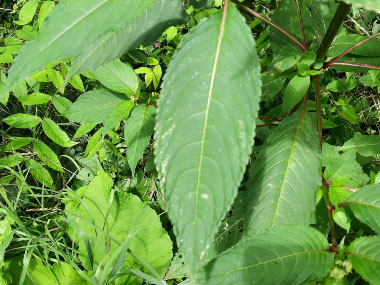

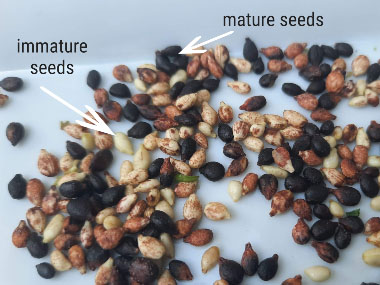
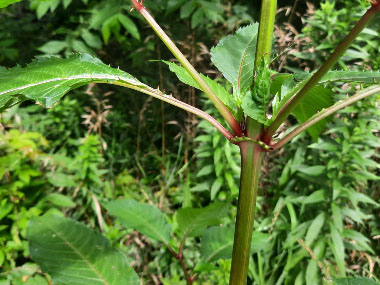
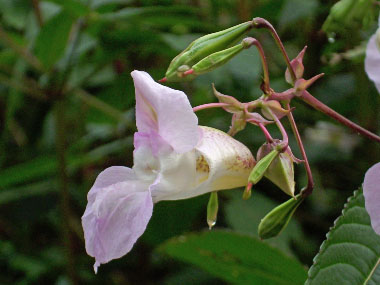
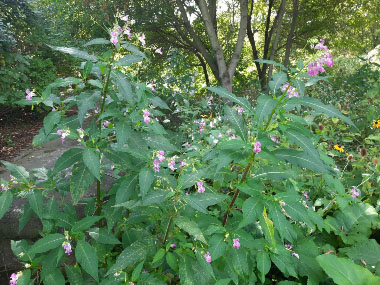
To support our efforts please browse our store (books with health benefits, etc.).
This majestic looking annual plant is native to the Himalayan region of Asia. It was brought to Europe and North America in the 1800s as an ornamental plant and it was thought to be in the ballast water of ships. This plant escaped gardens and quickly spread to many areas, particularly in wetlands and riparian areas. The flower glands produce large quantities of sweet-smelling nectar. Both the nectar and the plant’s long flowering period attract pollinators. An extraction of this plant is used in homeopathy to help with anxiety.
Distinguishing Features
Himalayan balsam’s most distinct feature is the mature seed pods. When they are under a lot of tension (fully mature) the slightest touch will cause them to jettison their seeds as far as 7m (21’) away; this a phenomenon known as indehiscence. They are very easy to spot when in bloom as they can grow extremely tall and have (mostly) pink flowers. If the main stem is cut above the first node, the plant will regrow in a candelabra effect, producing multiple flower heads resulting in the production of even more seeds.
Flowers
Flowers are pink, sometimes white, with a hooded shape. They grow in clusters of 5 to 10 flowers per stem. Bloom time can be quite long and is generally from May to October (depending on geographic region). The flowers are followed by seed pods, which contain up to 16 seeds in each pod. A single plant has the ability to produce about 800 seeds.
 Fields
of Nutrition has medicinal benefits and vitamin/mineral content of Himalayan Balsam.
Fields
of Nutrition has medicinal benefits and vitamin/mineral content of Himalayan Balsam.
Leaves
Leaves can vary from 5 to 25 cm (2 to 10”) long. They are whorled or opposite; lanceolate to lance-ovate with acuminate tips. Leaf margins are serrated.
Height
It can grow anywhere from 1 m (3’) to 3.5 m (10’) tall. Stems are hexagonal, purplish or red-tinged. They are smooth, hairless, hollow, and they are easily broken.
Habitat
This plant thrives in nutrient-rich, moist, natural areas, particularly in wetlands and riparian areas. It also can grow in moist soils that are not near water as well. It is tolerant of partial shade. This plant is primarily in the northern hemisphere as well as in New Zealand and Tasmania (Australia).
Edible Parts
Himilayan Balsam contains high levels of minerals, especially calcium oxalate, so consumption should be in moderation! (Cooking breaks this down.) Do not consume if you are pregnant, lactating, have arthritis, kidney or bladder ailment, have gout, or hyperacidity. Young leaves and flowers can be used in salads, while the older leaves are bitter and best used in soups and stews. The flowers can also be used to create color-changing beverages. This plant is commonly used in curries in India. Both the light colored (immature) seeds and dark mature seeds are edible. Seeds have a slight, nutty flavor. The immature seed pods can be cooked whole. The hollow stem can be used as a straw.
Other Name
Touch-Me-Not.
Similar Plants
Jewelweed.
Winter Survival Food Handbook

PDF Plant Magazines
Types of Wild Food
Geographic Zones Seasons
Disclaimer
EdibleWildFood.com is informational in nature. While we strive to be 100% accurate, it is solely up to the reader to ensure proper plant identification. Some wild plants are poisonous or can have serious adverse health effects.
We are not health professionals, medical doctors, nor are we nutritionists. It is up to the reader to verify nutritional information and health benefits with qualified professionals for all edible plants listed in this web site. Please click here for more information.
Why Edible Wild Food?
- Food costs are rising
- Free, wild food is readily abundant
- Wild food adds nutrition to your diet
- Wild food can help treat various medical conditions





